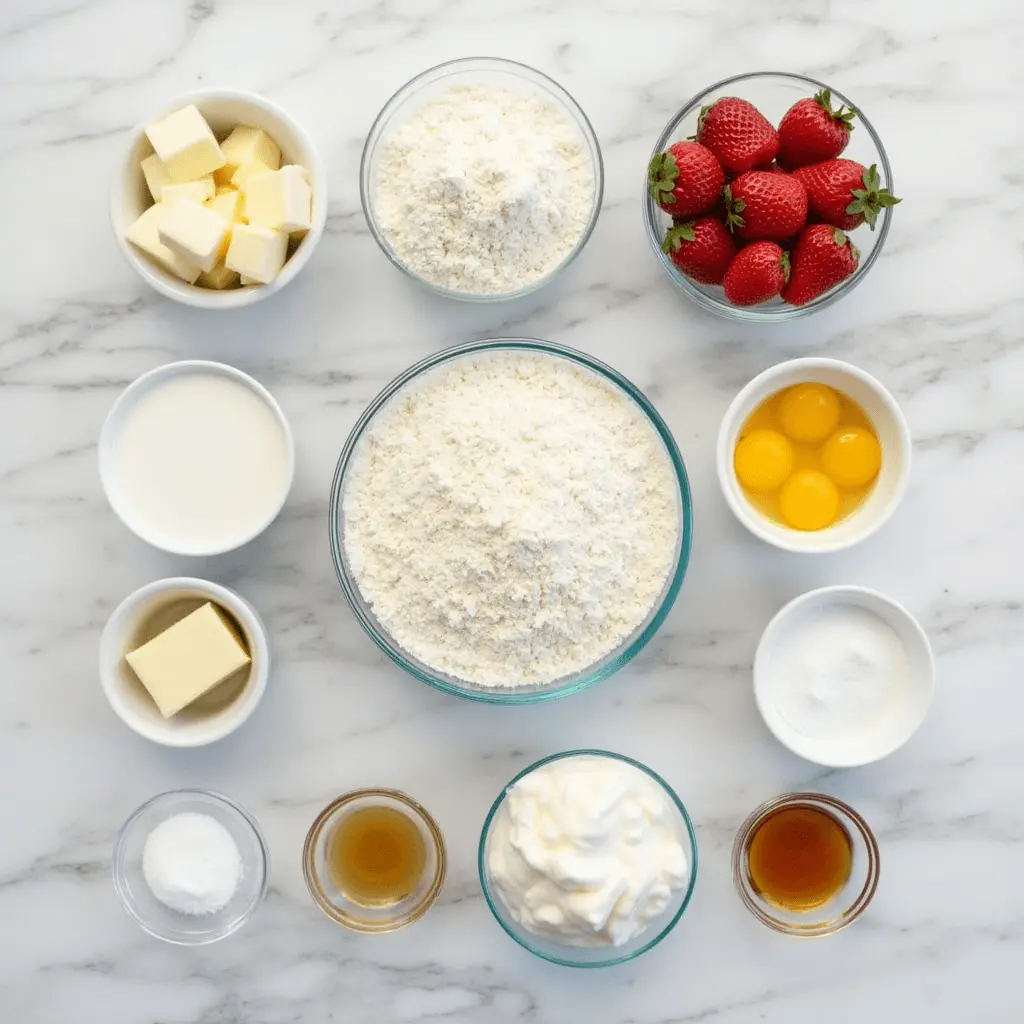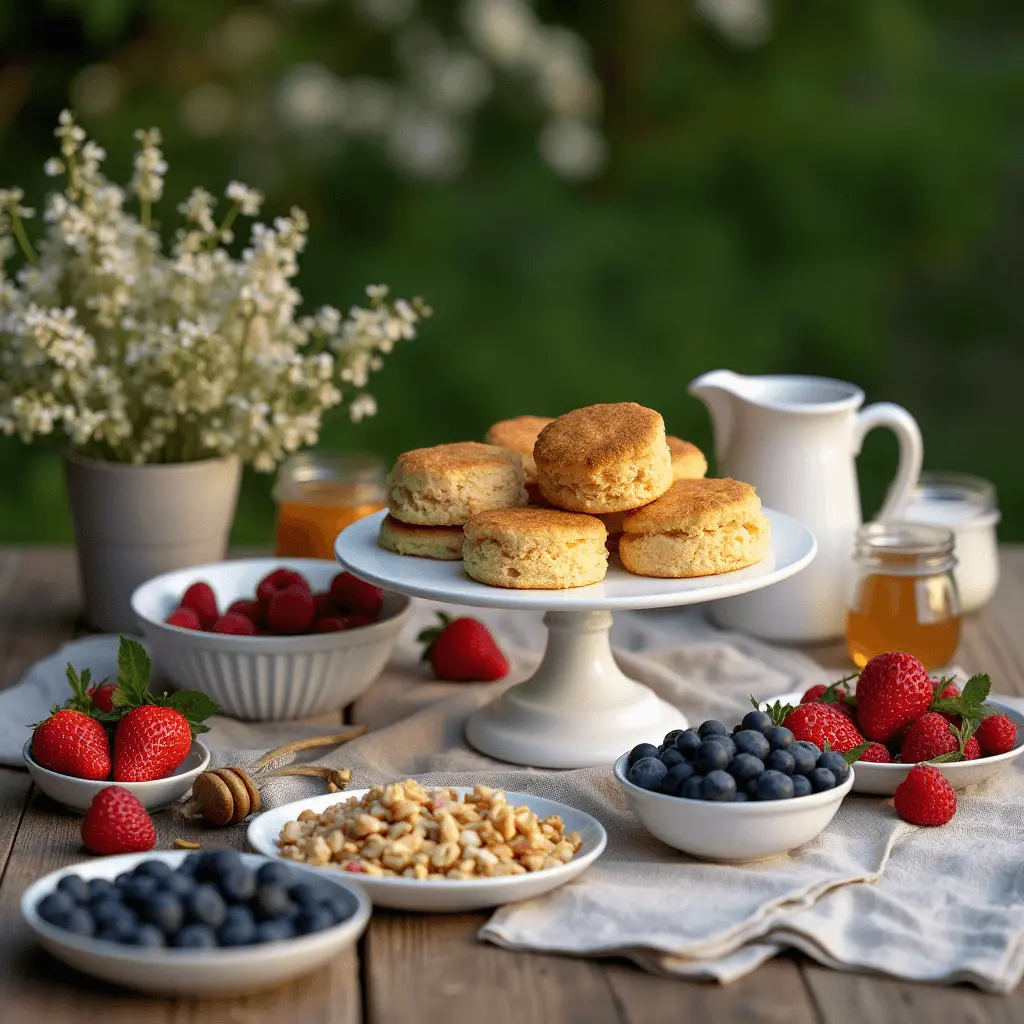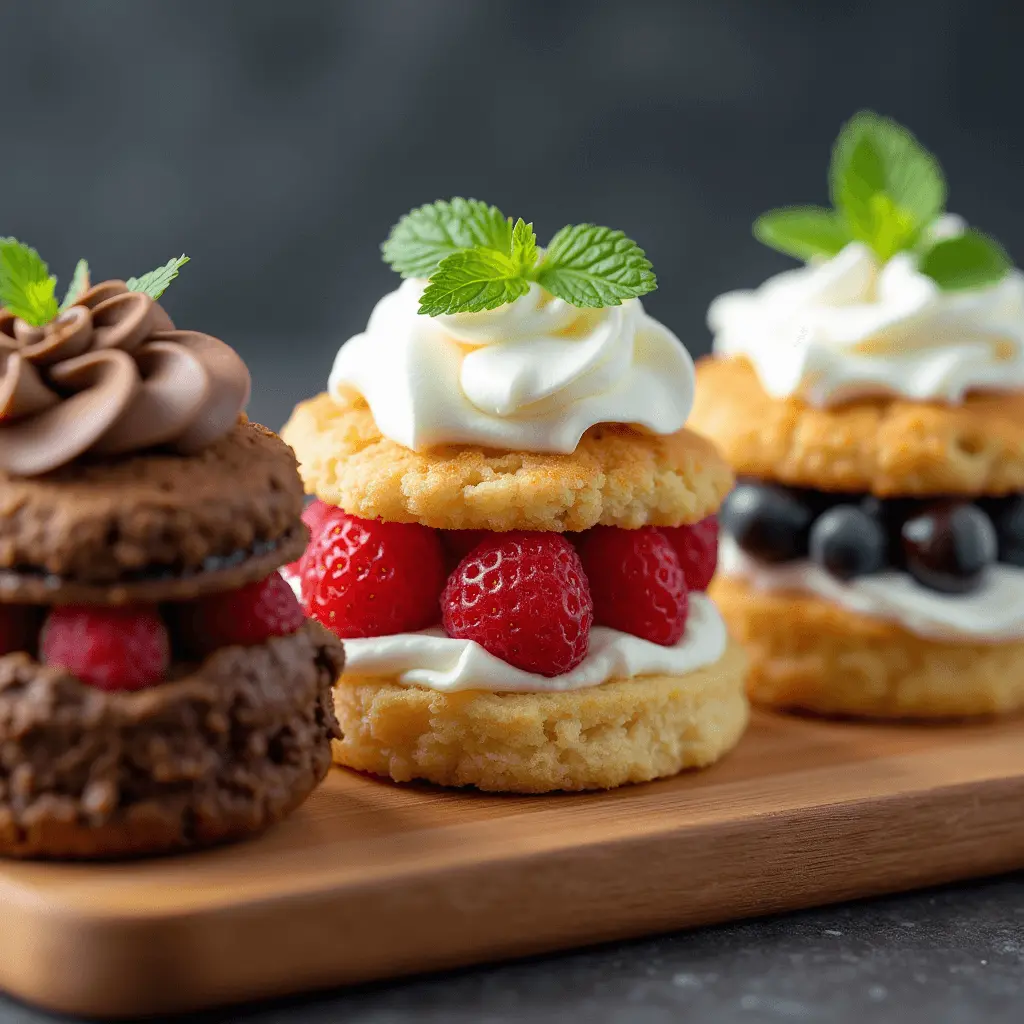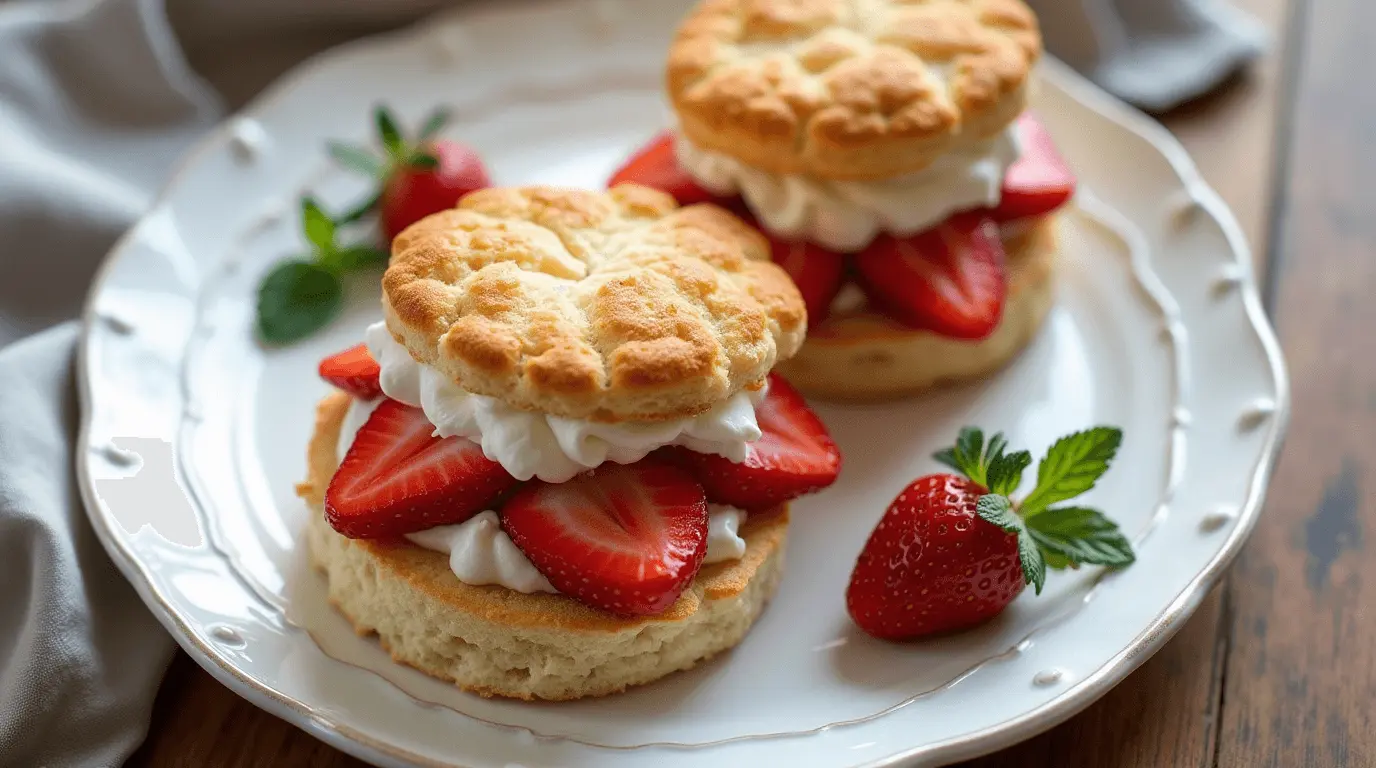Table of Contents
There’s something magical about biting into a perfectly light, sweet shortcake topped with juicy summer berries and a dollop of fresh whipped cream. That first bite instantly transports me back to my grandmother’s kitchen, where she’d make traditional shortcakes every summer when berries were at their peak. The kitchen would fill with the buttery, sweet aroma as those golden biscuits baked to perfection.
But when I was diagnosed with celiac disease eight years ago, I thought those carefree days of enjoying shortcake on the porch were over. Store bought gluten free versions were disappointing either too dense, too dry, or with that tell tale gritty texture that screams “gluten free substitute.” I missed the light, tender shortcakes that served as the perfect vehicle for summer’s bounty.
After countless test batches (and some spectacular failures that my family still teases me about), I finally cracked the code on gluten free shortcake that rivals and dare I say sometimes surpasses the traditional wheat versions I grew up loving. The secret lies not just in the right flour blend, but in understanding how gluten free ingredients work together to create that perfect texture.
What makes these gluten free shortcake recipes different from others you’ll find online is their authenticity. These aren’t sad substitutes or “good enough” alternatives they’re genuinely delicious desserts that everyone at your table will love, whether they avoid gluten or not. I’ve served these at countless summer gatherings, and the most common reaction is pure surprise when guests learn they’re gluten free shortcake.
Whether you’re newly diagnosed with celiac disease, cooking for someone with gluten sensitivity, or simply looking to expand your baking repertoire, these gluten free shortcake variations will bring the joy of this classic summer dessert back into your life without compromise.
Why These Gluten Free Shortcake Recipes Are a Must Try
Truly gluten free shortcake: Carefully tested recipes with zero cross contamination concerns for those with celiac disease or gluten sensitivity.
Perfect Texture: Light, fluffy, and tender no dense or gritty texture that often plagues gluten free baking.
Quick & Easy: Most variations take just 15-20 minutes to prep and 12-15 minutes to bake perfect for impromptu summer gatherings!
Family Approved: These gluten free shortcakes have passed the ultimate test picky eaters can’t tell they’re gluten free shortcake!
Versatile: Each base recipe can be customized with different fruits, flavor additions, or toppings to keep things interesting all summer long.
Make Ahead Friendly: Many components can be prepared in advance for stress free entertaining.
Beginner Friendly: Simple techniques that even novice bakers can master on the first try.
Budget Conscious: No expensive specialty ingredients just simple, wholesome foods you can find in most grocery stores.
Balanced Sweetness: Not overly sweet, allowing the natural flavors of fresh summer fruits to shine through.
Customizable: Easy to adapt for other dietary needs including dairy free and egg free versions.
Ingredients Breakdown & Substitutions for gluten free shortcake
Flour Blends
Gluten Free Flour Blend
- Why It’s Important: The foundation of your shortcake that provides structure and texture.
- Best Options: Look for blends containing rice flour, potato starch, and tapioca starch for the best texture.
- Substitution option: Create your own blend by mixing 2 cups of rice flour, 2/3 cup of potato starch, and 1/3 cup of tapioca starch.
Almond Flour
- Why It’s Important: Adds moisture, subtle flavor, and improves texture in gluten free shortcake baking.
- Substitutions: Sunflower seed flour for nut allergies, or increase your gluten-free flour blend by the same amount and add 1 tablespoon of oil for a better strawberry shortcake.
Oat Flour
- Why It’s Important: Adds a lovely flavor and helps create a tender crumb.
- Substitutions: Make sure to use certified gluten free oats. Can substitute with sorghum flour or additional all purpose gluten free blend.
Leavening Agents
Baking Powder
- Why It’s Important: Creates rise and fluffiness in your shortcakes.
- Substitutions: Ensure it’s gluten free (most are, but always check labels).
Xanthan Gum
- Why It’s Important: Acts as a binder in the absence of gluten, preventing crumbly texture in your gluten-free strawberry shortcake.
- Substitutions: Guar gum (use 1.5x the amount) or psyllium husk powder.
Fats
Butter
- Why It’s Important: Adds rich flavor and creates flaky layers in the shortcake.
- Substitutions: Cold coconut oil (solid state) or vegan butter for dairy free options.
Heavy Cream
- Why It’s Important: Adds richness and moisture to the dough.
- Substitutions: Full fat coconut milk or nut based creams for dairy free versions.
Sweeteners
Granulated Sugar
- Why It’s Important: Provides sweetness and helps with browning.
- Substitutions: Coconut sugar (will darken the color slightly) or a granulated sugar substitute.
Vanilla Extract
- Why It’s Important: Enhances the sweet flavors without adding additional sugar.
- Substitutions: Almond extract, lemon extract, or other flavor extracts depending on your fruit pairings.
Add ins and Toppings
Fresh Berries
- Why It’s Important: The star of any shortcake, providing natural sweetness and juiciness.
- Substitutions: Any fresh seasonal fruit works beautifully peaches, nectarines, plums, or cherries.
Whipped Cream
- Why It’s Important: The classic light and airy topping that brings everything together.
- Substitution options: Use coconut whipped cream for a dairy free alternative, or Greek yogurt for a tangier, protein packed choice.

Classic Gluten Free Shortcake Base Recipe: Step by Step Instructions
Let’s start with the perfect base recipe for gluten free shortcake that you can adapt for all ten variations. This recipe yields 8 shortcakes, enough for a family gathering or dinner party.
Ingredients
- 2 cups gluten free flour blend
- 1/4 cup almond flour
- 1/4 cup granulated sugar
- 1 tablespoon baking powder (gluten free)
- 1/2 teaspoon salt
- 1/2 teaspoon xanthan gum
- 6 tablespoons cold butter, cubed
- 1 large egg
- 2/3 cup cold heavy cream
- 1 teaspoon vanilla extract
- 2 tablespoons turbinado sugar for topping (optional)
Instructions
1- Preheat and Prepare: Set your oven to 425°F (220°C) and line a baking sheet with parchment paper to prepare for your gluten-free strawberry shortcake. An oven thermometer ensures your oven is actually at the right temperature, which is crucial for gluten free shortcake baking.
2- Mix Dry Ingredients: In a large bowl, whisk together the gluten free flour, almond flour, sugar, baking powder, salt, and xanthan gum until well combined. Whisking incorporates air and ensures even distribution of leavening agents.
3- Cut in Butter: Add the cold cubed butter to the flour mixture. Using a pastry cutter, two forks, or your fingertips, work the butter into the flour until the mixture resembles coarse crumbs with some pea sized pieces remaining. The secret to flaky gluten free shortcake is leaving some larger butter pieces intact!
4- Mix Wet Ingredients: In a separate small bowl, whisk together the egg, cold heavy cream, and vanilla extract.
5- Combine Mixtures: Make a well in the center of the dry ingredients and pour in the wet mixture. Using a fork, gently stir just until the dough starts to come together. Avoid overmixing! This is one of the most common mistakes in gluten free baking and leads to tough shortcakes.
6- Form the Dough: Turn the dough onto a lightly floured (with gluten free shortcake flour) surface. Gently pat the dough into a circle about ¾ inch thick. If your dough feels too sticky, dust your hands with a little gluten free flour rather than adding more to the dough.
7- Cut Shortcakes: Using a 2.5 inch round biscuit cutter, cut straight down into the dough without twisting. Pressing rather than twisting helps maintain open edges for proper expansion. Place shortcakes on the prepared baking sheet about 2 inches apart.
8- Chill: Place the baking sheet in the refrigerator for 15 minutes before baking. This extra step keeps the butter cold, which creates steam during baking for flakier gluten free shortcake .
9- Brush and Sprinkle: Just before baking, lightly brush the tops with a little heavy cream and sprinkle with turbinado sugar if desired. This creates a beautiful golden crust with a slight crunch.
10- Bake to Perfection: Bake for 12-15 minutes until golden brown on top and firm to the touch. If your oven heats unevenly, turn the pan around midway through the cooking time and Ensure your oven is properly calibrated for the best gluten free shortcake strawberry results.
Troubleshooting Tips
- If your dough is too dry: Add 1 tablespoon of cold cream at a time until it comes together.
- If your dough is too wet: Add 1 tablespoon of gluten free shortcake flour at a time, being careful not to overwork the dough.
- If your shortcakes aren’t rising: Check that your baking powder is fresh (should be replaced every 6-12 months).
- If edges are crumbly when cutting: Dip your cutter in gluten free flour between cuts.
- If tops are browning too quickly: Place a piece of aluminum foil loosely over the shortcakes.

Storage, Make Ahead & Freezing Tips for gluten free shortcake
Gluten-free shortcakes are best enjoyed fresh, but with the right storage techniques, you can prepare components in advance or save leftovers for later strawberry shortcakes.
Fresh Shortcakes
- Counter Storage: Store completely cooled shortcakes in an airtight container at room temperature for up to 2 days. Add a paper towel to the container to help absorb any excess moisture.
- Refresh: To revive day old shortcakes, warm in a 300°F oven for 5 minutes before serving.
Refrigeration
- Assembled Shortcakes: Once assembled with fruit and cream, shortcakes should be eaten immediately (they’ll get soggy if stored).
- Shortcake Dough: A crucial step in creating your gluten-free strawberry shortcake: The dough can be prepared, cut into rounds, and refrigerated for up to 24 hours before baking. Cover with plastic wrap to prevent drying.
- Macerated Fruit: Prepare fruit topping up to 4 hours ahead and refrigerate. The longer it sits, the more juices will develop.
- Whipped Cream: Can be made up to 4 hours ahead and refrigerated. Whip it slightly stiffer than usual as it will soften over time.
Freezing
- Unbaked Shortcakes: Place cut shortcake rounds on a baking sheet and freeze until solid, then transfer to a freezer bag for up to 3 months. No need to thaw before baking just add 3-5 minutes to the bake time.
- Baked Shortcakes: Wrap individually in plastic wrap, then aluminum foil, and freeze for up to 2 months. Thaw at room temperature then reheat at 300°F for 5-7 minutes to restore texture.Perfect for layering with sliced strawberries.
Creative Uses for Leftover Shortcakes
- Crumble and use as a topping for ice cream or yogurt parfaits
- Cube and toast for a gluten free berry trifle
- Transform into a bread pudding with a simple custard
- Create shortcake “french toast” for breakfast the next day
Creative Variations & Serving Ideas
Ready to take your gluten free shortcake game to the next level? Here are my favorite ways to transform the classic base recipe into showstopping desserts that will have everyone asking for seconds!
Fun Flavor Twists
- Lemon Blueberry Shortcake Add 1 tablespoon of lemon zest to the dry ingredients and fold in 1/2 cup fresh blueberries just before forming the dough. Finish with whipped cream flavored with lemon and additional fresh blueberries on top
- Chocolate Strawberry Shortcake Mix 2 tablespoons of unsweetened cocoa powder into the dry ingredients and fold in 1/3 cup mini chocolate chips. The chocolate shortcake base pairs beautifully with fresh strawberries and classic whipped cream.
- Cinnamon Apple Shortcake Add 1 teaspoon of cinnamon to the dry ingredients for a unique twist on your gluten-free strawberry shortcake. Instead of berries, top with sautéed cinnamon apples (perfect for early fall when summer berries are fading but it’s not quite pumpkin season).
- Coconut Mango Shortcake topped with juicy strawberries. Replace 1/4 cup of the gluten free shortcake flour with coconut flour, add 1/4 cup toasted coconut flakes to the dough, and serve with fresh mango and coconut whipped cream for a tropical twist.
- Spiced Peach Shortcake Add 1/2 teaspoon each of cinnamon and ginger to the dry ingredients, and top with honey drizzled fresh peaches for a Southern inspired dessert that screams summer.

Creative Serving Ideas
- Shortcake Sundae Bar Set up a build your own shortcake station with warmed shortcakes, multiple fruit options, whipped cream, and various toppings like toasted nuts, chocolate sauce, and caramel.
- Mini Shortcake Sliders Make tiny 1 inch shortcakes, slice them horizontally, and create adorable dessert “sliders” that are perfect for parties or children.
- Shortcake Trifle Layer cubed shortcakes with fruit and cream in a trifle dish for a stunning centerpiece dessert that serves a crowd.
- Butter and briefly grill the cut sides of shortcakes for a smoky, caramelized flavor that perfectly complements grilled peaches or pineapple.
- Layer crumbled leftover shortcakes with Greek yogurt, fresh fruit, and a honey drizzle for a special breakfast parfait.
Perfect summer pairings for your gluten free shortcake include iced mint tea, sparkling rosé, lemonade, or cold brew coffee with a splash of cream. For a truly decadent experience, serve your warm shortcake with a scoop of vanilla ice cream alongside the traditional whipped cream!
Nutrition Information
Understanding the nutritional content of your gluten free shortcakes can help you make informed choices about serving sizes and frequency. Below is the approximate nutritional information for one plain shortcake (without toppings) from our base recipe:
| Nutrient | Amount per Shortcake |
| Calories | 275 |
| Total Fat | 14g |
| Saturated Fat | 8g |
| Cholesterol | 55mg |
| Sodium | 220mg |
| Total Carbohydrates | 35g |
| Dietary Fiber | 1.5g |
| Sugars | 10g |
| Protein | 3g |
| Calcium | 8% DV |
| Iron | 6% DV |
Note: Nutritional values will vary based on specific brands of gluten free shortcake flour used and any additions or substitutions. When using dairy free alternatives like coconut oil instead of butter, the fat profile will change slightly.
The fruit toppings add minimal calories while providing essential vitamins, antioxidants, and fiber. One cup of fresh strawberries, for example, adds only about 50 calories but provides 150% of your daily Vitamin C needs!
Whipped cream adds approximately 50-75 calories per 2 tablespoon serving, while dairy-free alternatives may vary when making strawberry shortcake. For a lighter option, consider using Greek yogurt sweetened with a touch of honey as your creamy topping.
These shortcakes can easily be adapted for various dietary needs while maintaining their nutritional profile. For example, using coconut sugar instead of white sugar provides the same calories but adds small amounts of nutrients not found in refined sugar.
Expert Tips & FAQs for gluten free shortcake
Pro Tips for Perfect Gluten Free Shortcakes
- Temperature matters Keep your butter and cream COLD until the moment you use them. I even chill my mixing bowl before starting! This creates those beautiful flaky layers in the final shortcake.
- Measure by weight For the most consistent results, use a kitchen scale to measure your gluten free flours. Volume measurements (cups) can vary significantly based on how you scoop.
- Don’t overwork the dough gluten free shortcake dough doesn’t have the same elasticity as wheat based dough, and overworking it will make your shortcakes tough instead of tender.
- Let them rest Allow your shortcakes to cool for at least 10 minutes before slicing. This gives the structure time to set and prevents crumbling.
- The “drop” method works too If you’re short on time, skip the rolling and cutting. Simply drop large spoonfuls of dough onto your baking sheet for a more rustic shortcake that tastes just as delicious.
Frequently Asked Questions
Why did my gluten free shortcakes turn out gritty?
This usually happens when using rice flour heavy blends without enough starch to balance the texture. Make sure your flour blend contains tapioca starch and potato starch. Another cause could be using almond flour that isn’t finely ground always look for “super fine” almond flour for the best texture.
Can I make these shortcakes vegan?
Absolutely! Replace the butter with solid coconut oil or vegan butter, use full fat coconut milk instead of heavy cream, and substitute the egg with a flax egg (1 tablespoon ground flaxseed mixed with 3 tablespoons water, let sit for 5 minutes until gelled). You may need to add an extra 1/4 teaspoon of xanthan gum to compensate for the binding properties of the egg.
My shortcakes didn’t rise much. What went wrong?
Three common culprits: First, check that your baking powder is fresh it loses potency after about 6 months. Second, your oven might not be hot enough use an oven thermometer to verify the temperature. Third, if you skipped the chilling step, the butter might have been too warm when the shortcakes went into the oven.
How can I ensure my shortcakes don’t fall apart when I split them?
Instead of cutting baked shortcakes horizontally, try this baker’s trick: before baking, press the center of each dough round with your thumb to create a slight indentation. This natural fault line makes it easier to split the baked shortcakes without crumbling.
Can I use a food processor to cut in the butter?
Yes, but with caution! Blend briefly until the mixture forms coarse crumbs. Overprocessing will warm the butter and result in less flaky shortcakes. I still prefer the manual method using a pastry cutter or two forks for the best texture.
Conclusion & Call to Action
Bringing the joy of shortcake back to your gluten free table doesn’t have to be complicated! With the right techniques and ingredients, these gluten free shortcake can become your signature summer dessert one that everyone at your table will love, whether they avoid gluten or not.
What I love most about these shortcakes is their versatility. From the classic strawberry topping to more adventurous flavor combinations, there’s a variation to suit every taste and occasion. The simple base recipe provides endless possibilities for creativity while maintaining that perfect tender, flaky texture that makes shortcake so irresistible.
Remember that gluten free baking is part science, part art don’t be discouraged if your first batch isn’t perfect! Each time you make these shortcakes, you’ll learn something new about working with gluten free ingredients and develop your own special touches.
Have you tried making gluten free shortcakes before? Which of these ten variations sounds most tempting to you? I’d love to hear about your experiences and flavor combinations in the comments below!
Don’t forget to subscribe to my newsletter for more seasonal, gluten free shortcake recipes delivered straight to your inbox. You can also follow me on Instagram where I share step by step baking tutorials and troubleshooting tips for gluten free baking success!
Happy baking, and may your summer be filled with delicious shortcake memories!


1 thought on “Gluten Free Shortcake Recipe ”
Comments are closed.